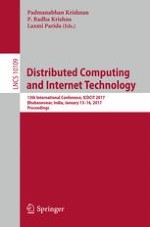2017 | Buch
Distributed Computing and Internet Technology
13th International Conference, ICDCIT 2017, Bhubaneswar, India, January 13-16, 2017, Proceedings
herausgegeben von: Padmanabhan Krishnan, P. Radha Krishna, Laxmi Parida
Verlag: Springer International Publishing
Buchreihe : Lecture Notes in Computer Science
